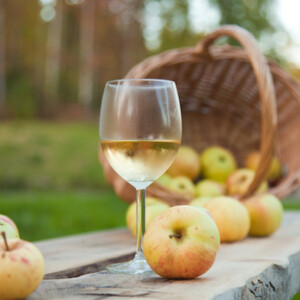Apple Wine
Homemade apple wine is light, sweet and delicious. This easy winemaking recipe uses any apple juice to craft a delicious apple wine, perfect for sharing with friends.
Servings: 1 gallon, or about 4 bottles
Equipment
Ingredients
- 1- gallon apple juice see note
- 1 pound Sugar about 2 cups
- 1 teaspoon yeast nutrient
- 1 teaspoon acid blend
- 1/2 teaspoon Pectic Enzyme
- 1/4 teaspoon tannin powder
- wine yeast see note
- Optional ~ Campden Tablet and Potassium Sorbate for Stabilizing I do not use these
Instructions
- Start by removing about 1 quart (4 cups) of juice from the gallon, then pour the remaining 3 quarts into your fermentation vessel.
- Take 2 cups of the juice you removed and place it in a small saucepan, setting aside the other 2 cups for later use. Gently warm the juice in the saucepan over low heat.
- Once warm, add all the other ingredients (except the yeast) to the saucepan and stir until everything dissolves completely. Turn off the heat and allow the mixture to cool to room temperature.
- When the juice mixture has cooled, pour it into the fermentation vessel with the rest of the apple juice.
- In a small container, dissolve the winemaking yeast in about 1/4 cup of unchlorinated water. You’ll only need 1/5 to 1/2 of the yeast packet for this batch, so set aside the rest. Let the yeast sit for about 10 minutes to rehydrate.
- Once the yeast has hydrated, add it to the fermentation vessel with the apple juice mixture.
- Top off the fermentation vessel with the remaining apple juice you set aside earlier, filling it until the juice reaches the base of the neck. Be sure to leave 2-3 inches of headspace to allow for bubbling during fermentation.
- Cap the vessel with a rubber bung and attach a water lock filled with water. Place the fermentation vessel in a cool, dark area and allow it to ferment for 7 to 10 days. You should see active bubbling. If the bubbling pushes juice into the water lock, clean it out and reattach the lock as needed.
- After primary fermentation, use a brewing siphon to transfer the wine into a clean vessel, leaving behind any sediment.
- Re-seal the new vessel with a water lock and let it continue fermenting in a cool, dark place for at least 6 weeks, though it’s better to allow it to ferment for several months, up to 6 months, for a smoother taste.
- Once fermentation has fully finished, carefully bottle the apple wine in clean wine bottles. Store the bottles in a cool, dark place and let them age for at least one month. The wine will improve with age, and if you prefer a sweeter wine, you may need to back-sweeten it at this point (see notes for back-sweetening instructions).
Notes
Amount of Juice ~ You'll need slightly less than 1 gallon of juice for this recipe, since the other ingredients take up some space in the carboy. I started with one gallon of juice and had 12 ounces left at the end as "extra." You may have more or less depending on your choice of fermentation vessel.
Yeast ~ For apple wine, you want a yeast that adds light fruity flavors (or simply ferments clean without added flavor). Good yeast choices include Lavin D47, Lalvin QA23, Red Star Premier Cuvee or Lavin EC-1118. See notes within the article for specific qualities of each yeast.
Stabilizing and Back Sweetening ~ If at the end of secondary, the wine is too dry for your tastes, back sweetening is an option. First, move the wine to a clean container (to avoid stirring up the sediment), then add 1 Campden tablet and 1/2 teaspoon potassium sorbate to stabilize the wine (kill the yeast). If the wine isn't stabilized before adding more sugar, it will rapidly ferment in the bottle with the added sugar and can cause bottles to burst under pressure.
Once stabilized, add sugar to taste. Make a simple syrup by dissolving equal parts sugar and water together in a saucepan, and then add that to the wine before bottling. Amounts will vary based on your taste, but I'd suggest starting with about 1/2 cup of sugar for one gallon of apple wine.
See notes within the article regarding stabilizing and back sweetening.
